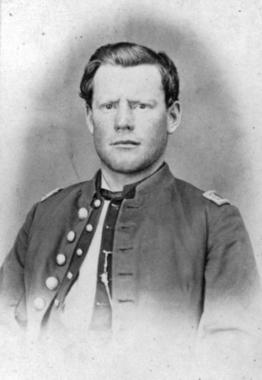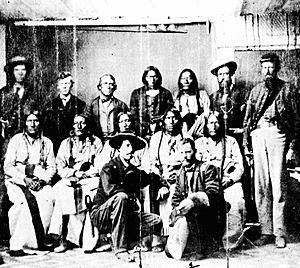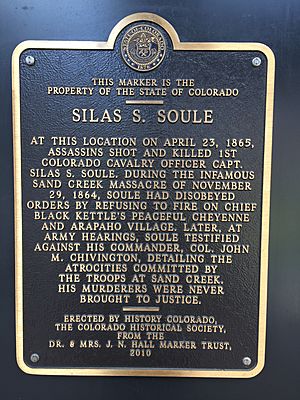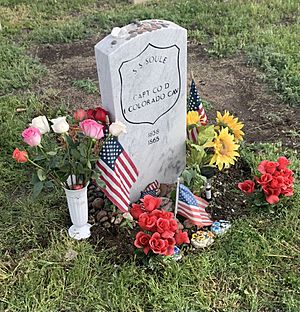Silas Soule facts for kids
Quick facts for kids
Silas S. Soule
|
|
|---|---|

Soule c. 1864
|
|
| Born | July 26, 1838 Bath, Maine, United States |
| Died | April 23, 1865 (aged 26) Denver, Colorado Territory, United States |
| Place of burial |
Riverside Cemetery (Denver, Colorado)
|
| Allegiance | United States |
| Service/ |
Union Army |
| Years of service | 1861–1865 |
| Rank | Captain |
| Unit | 1st Colorado Infantry 1st Colorado Cavalry |
| Commands held | Company D, 1st Colorado Cavalry |
| Battles/wars | American Civil War |
| Spouse(s) |
Thersa A. Coberly
(m. 1865) |
Silas Stillman Soule (born July 26, 1838 – died April 23, 1865) was an American hero who fought against slavery. He was part of a group called abolitionists, who wanted to end slavery in the United States. Silas also joined the Union Army during the American Civil War. He became a Captain and led Company D, 1st Colorado Cavalry.
Silas Soule is famous for refusing to take part in the Sand Creek massacre in 1864. He saw that the Native Americans were peaceful and would not attack them. Later, he bravely spoke out against the massacre's leader, John Chivington. Sadly, Silas Soule was murdered in Denver soon after his testimony.
Contents
Early Life and Fighting Slavery
Silas Soule was born in Bath, Maine, into a family that strongly opposed slavery. In 1854, his family moved to the Kansas Territory. They joined a group called the New England Emigrant Aid Company. This group wanted to help Kansas become a "free state," meaning a state where slavery was not allowed.
Silas's family settled near Lawrence. His father, Amasa Soule, made their home a stop on the Underground Railroad. This was a secret network of safe houses and routes that helped enslaved people escape to freedom in the North. When Silas was just 17, he helped guide people escaping slavery from Missouri to safety.
His sister, Anne Julia Soule Prentiss, once shared a story about their family. She said, "Our house was on the 'Underground Railway'. John Brown was often there... My brother, Silas, and Brown were close friends." She remembered a time when John Brown brought 13 enslaved people to their cabin. Silas then took all 13 of them to another safe house eight miles away.
Trouble in "Bleeding Kansas"
Before the Civil War, Kansas was a very dangerous place. People who supported slavery and those who opposed it were often fighting. This time was known as "Bleeding Kansas." Silas Soule became known as a brave and clever fighter during these conflicts.
In 1859, Silas helped free a doctor named John Doy. Dr. Doy had been arrested in Missouri for helping 13 formerly enslaved people escape. Silas went into the jail in St. Joseph where Doy was held. He tricked the jailer and helped Doy escape back to Kansas. After their escape, Silas and the other men who helped were photographed. This picture is famous and shows "The Immortal Ten."
Silas also tried to help John Brown escape from jail. Brown was captured after his raid on Harper's Ferry. Silas visited Brown in jail and offered to plan an escape. However, Brown refused. He wanted to become a martyr, meaning he believed his death would help the fight against slavery. Silas later met the poet Walt Whitman in Boston.
Life in Colorado and the Civil War

In May 1860, Silas moved to Colorado with his brother and cousin. He worked digging for gold and in a blacksmith shop.
When the American Civil War began in 1861, Silas joined the 1st Colorado Infantry. He fought in the Battle of Glorieta Pass in 1862, which the Union won. He rose through the ranks and, by November 1864, became a Captain. He was given command of Company D, 1st Colorado Cavalry.
The Sand Creek Massacre
On November 29, 1864, Captain Soule and Lieutenant Joseph Cramer were with their companies at Sand Creek, Colorado. Colonel John Chivington ordered his troops to attack a peaceful village of Cheyenne people led by Chief Black Kettle.
However, Soule saw that the Cheyennes were flying the Union flag, which was a sign of peace. He and Lieutenant Cramer refused to attack. They ordered their men to hold their fire and stay in place. Most of the other soldiers, however, did attack the village. This terrible event became known as the Sand Creek Massacre. It was one of the worst acts of violence against Native Americans in U.S. history.
Silas Soule wrote a letter to his friend, Major Edward W. Wynkoop, describing what he saw:
"I refused to fire, and swore that none but a coward would, for by this time hundreds of women and children were coming towards us, and getting on their knees for mercy. I tell you Ned it was hard to see little children on their knees have their brains beat out by men professing to be civilized. ... I saw two Indians hold one of another's hands, chased until they were exhausted, when they kneeled down, and clasped each other around the neck and were both shot together."
The Sand Creek Massacre shocked people across the country. The U.S. Army and Congress started investigations. Silas Soule bravely testified against Colonel Chivington in a military court in February 1865. His testimony helped lead to Chivington's resignation.
Marriage and Death
On April 1, 1865, Silas Soule married Thersa A. "Hersa" Coberly. Just 22 days later, Silas was murdered.
On April 23, 1865, Silas was working as a Provost Marshal in Denver. He went to investigate gunshots and was shot by Charles Squier. Silas died before help arrived. His murder happened just two weeks after the Civil War ended.
Squier escaped but was later caught. However, the officer who captured Squier was found dead, and Squier escaped again to New York. He later died in 1869 from injuries after a railroad accident.
Remembering Silas Soule
Captain Silas S. Soule is buried at Riverside Cemetery in Denver, Colorado. Lieutenant Joseph A. Cramer, who also refused to take part in the Sand Creek Massacre, is buried in Kansas.
For many years, a special event called a Spiritual Healing Run/Walk was held in November. It started at the Sand Creek Massacre National Historic Site and ended at the Colorado State Capitol. Since 2010, a memorial ceremony has also been held at Soule's grave site. Another ceremony takes place in Denver where a plaque honors Soule near the spot where he was murdered. Representatives from Native American tribes and the National Park Service attend these ceremonies to honor Silas Soule and the victims of the Sand Creek Massacre.




